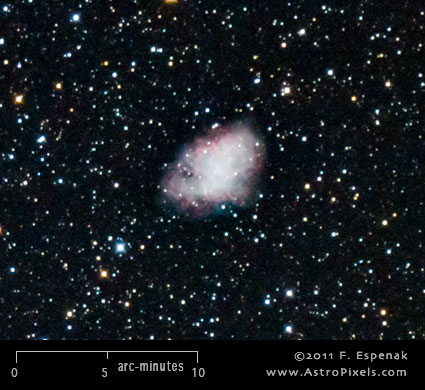
M1 - Crab Nebula
Messier 1 or M1 (also designated NGC 1952) is a supernova remnant in the constellation Taurus. It has an apparent visual magnitude of 8.4 and its angular diameter is 6x4 arc-minutes. M1 lies at an estimated distance of 6300 light years. The Equinox 2000 coordinates are RA= 5h 34.5m, Dec= +22° 01´ which makes M1 best seen during the winter. The Messier Winter Star Chart shows the position of all Messier objects visible during that season. As one of the more famous objects in the Messier Catalog, it is commonly known as the Crab Nebula.
The image above shows the uncropped view of M1 through the Takahashi E-180 Astrograph (North is up). The bright star to the lower left is Zeta Tauri (magnitude = +2.97). A 3x enlargement of this image appears to the right.
In the summer of 1054, Chinese and Arab astronomers recorded a "guest star" in the constellation Taurus that was brighter than Venus and visible in the daytime for several weeks. The Anasazi probably recorded it in a wall painting in Chaco Canyon, New Mexico. The Crab Nebula has been identified as the remnant of this supernova - a massive star that collapsed after exhausting its supply of fuel nuclear resulting as a spectacular explosion. M1 is the outwardly expanding shell of ionized gas thrown off in this cataclysmic event.
In spite of its inclusion in the Messier Catalog, this supernova remnant was actually discovered by J. Bevis in 1731. Charles Messier independently discovered it in 1758, while searching for the first predicted return of Halley's Comet. He thought it might be a comet but further observations showed that it did not move among the background stars. The discovery of this object inspired Messier to compile a list of similar false-positives so that they would not be confused with real comets. According to Stoyan et al. (2010), the distance of M1 is 6200 light years and its diameter is 10 light years. Since the supernova explosion occurred in 1054, the Crab Nebula is nearly 1000 years old.
For more information, see the Messier Catalog as well as specific entries for M1 in Wikipedia and SEDS.
Messier's Description of M1
September 12, 1758
`Nebula above the southern horn of Taurus, it doesn't contain any star;
it is a whitish light, elongated in the shape of a flame of a candle,
discovered while observing the comet of 1758. See the chart of that comet,
Mem. Acad. of the year 1759, page 188; observed by Dr. Bevis in about
1731. It is reported on the English Atlas Coelestis.'
Technical Details
- Object: M1
- Other Names: NGC 1952, Crab Nebula
- Object Type: supernova remnant
- Object Data: Apparent Magnitude = 8.4, Angular Size = 6x4 arc-minutes
- Object Position (Equinox 2000): RA= 5h 34.5m, Dec= +22° 01´, Constellation = Taurus
- Date/Time: 2011 Apr 05 at 03:22 UTC
- Location: Bifrost Astronomical Observatory, Portal, AZ
- Mount: Astro-Physics 1200GTO
- Telescope: Takahashi Epsilon 180 Hyperbolic Astrograph
- Camera: Canon EOS 550D (Rebel T2i) (modified with a Baader UV/IR filter)
- Field of View: 1.70° x 2.56° at 1.7 arc-sec/pixel (web version: 10.0 arc-sec/pixel)
- Exposure: 4 x 300s, f/2.8, ISO 800
- File Name: M1-01w.jpg
- Processing (Adobe Camera Raw): Graduated Filter, Vignetting Correction, Noise Reduction, White Balance, Curves
- Processing (Photoshop CS5): Average Images, Curves, Noise Reduction
- Original Image Size: 3454 × 5179 pixels (17.9 MP); 11.5" x 17.3" @ 300 dpi
- Rights: Copyright 2011 by Fred Espenak. All Rights Reserved. See: Image Licensing.
